|
 |
| [Special thanks to Andrew Blanton for creating the banner above. Many thanks to Sazmanab and Sohrab Kashani for hosting this event. Also thanks to Morehshin Allahyari for a great co-curatorial experience, to all the participating artists, and to all those who came to see the show.] |
by Morehshin Allahyari and Alysse StepanianOur perception of reality conforms to human-made logic while the construct of logic is defined by the limitations of our perceptions. The language of power is built upon the illusion of logic, designed to create cultural hegemony and maintain social hierarchies. The subversive video animations in this show challenge the language of logic and control in unexpected worlds of simulated realities. On one level, the nature of the GUI (graphic user interface) of video and animation software directly influences the creative process, as the program itself exerts a self-contained logic and control rooted in the code and interface design. On another level, the medium of video animation in these experimental works allows visualizations of unfamiliar realities that call for reinterpretations and active participation from the viewer. |
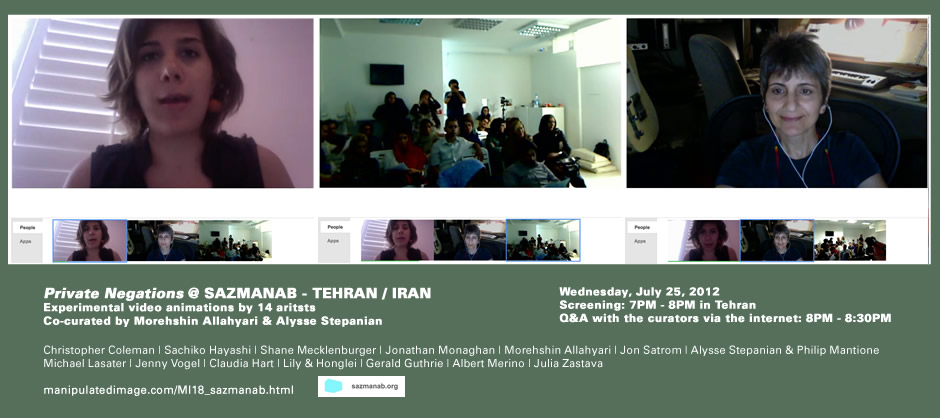 |
|---|
PROGRAM (Run Time: 62:26)Christopher Coleman (Colorado, USA) "Modern Times" 2:46 min, 2004, color, stereo, animation, 4:3 Sachiko Hayashi (Sweden) "N00sphere Playground" 2:58 min, 2008, color, stereo, machinima, 16:9 Shane Mecklenburger (Ohio, USA) "Halcyon Atmosphere" 3 min, 2009, B&W, sound Jonathan Monaghan (Brooklyn, New York) "Dauphin 007" 3:11 min, 2011, color, sound, CGI animated HD film on BluRay disc, 16:9 Morehshin Allahyari (Dallas & Denver, USA) "The Romantic Self-Exiles" 5:05 min, 2012, HD 3D animation, Color/B&W, sound Jon Satrom (Chicago, USA ) "QTzrk_loop" 03:12 min, 2011, color, sound Alysse Stepanian & Philip Mantione (Los Angeles) "alysse 9.1" 2:57 min, 2001, Color/B&W, stereo, 4:3 Michael Lasater (Indiana, USA) "Epiphany" 5:17 min, 2006, color, sound, digital animation, 16:9 Jenny Vogel (New York & Dallas, USA ) "The Beauty of All Things Falling" 4:30 min, 2011, Color/B&W, silent |
Lily & Honglei (New York) Sazmanab is an independent non-profit art space in Iran established in 2009. Sazmanab supports artistic work in a wide range of media through exhibitions and events, residencies for artists and curators, educational initiatives, talks and publications. By establishing local and international relationships, as well as diversifying both the practitioners and audiences of contemporary art, Sazmanab aims to support and expand the knowledge, appreciation and practice of contemporary arts in Iran and to promote Iranian arts and artists locally and internationally through its programming and outreach activities.  |
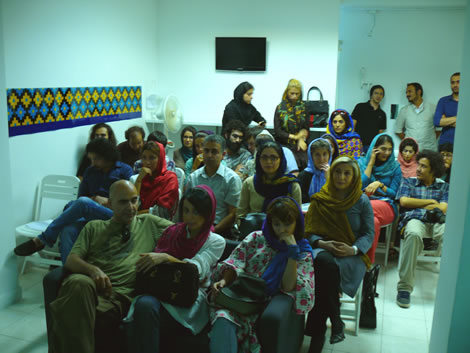 |
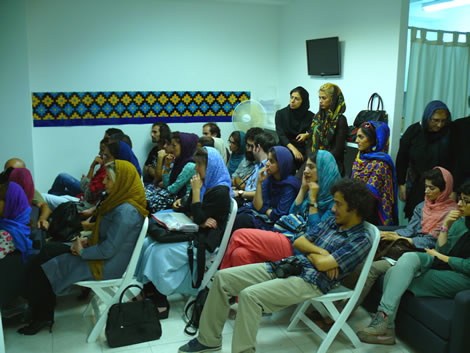 |
|---|---|
 |
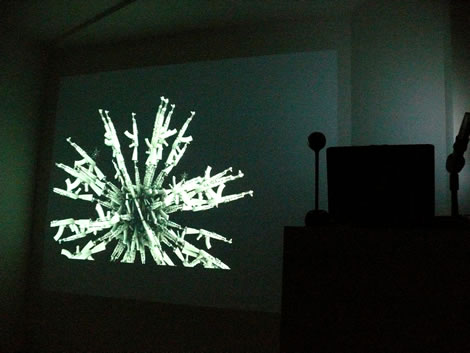 |
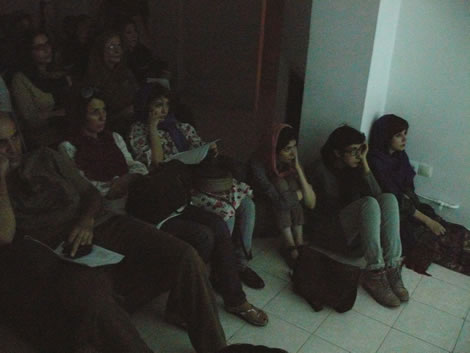 |
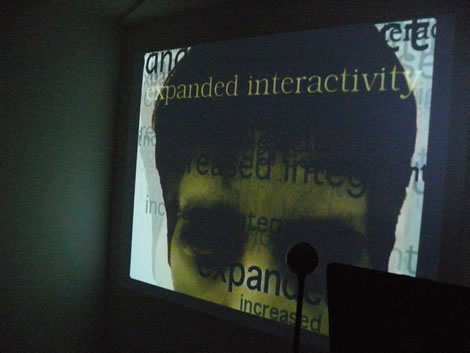 |
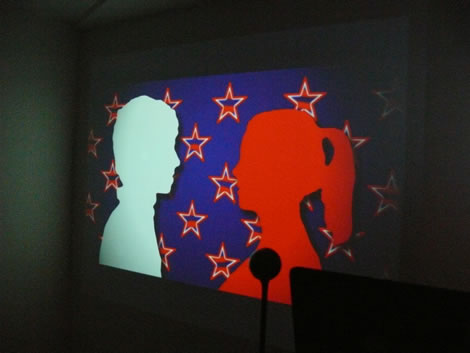 |
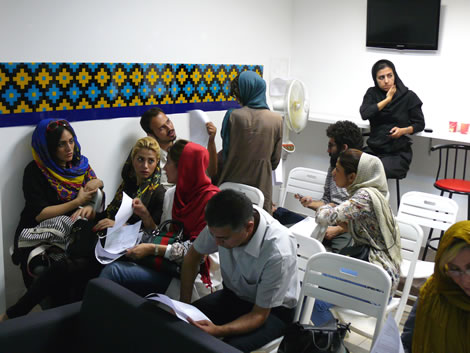 |
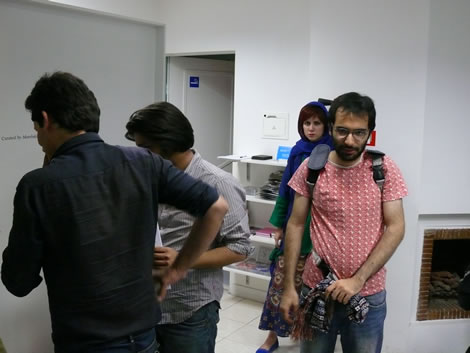 |
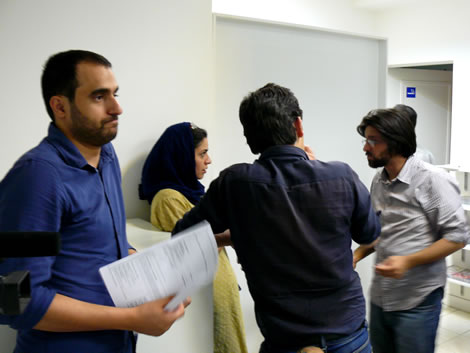 |
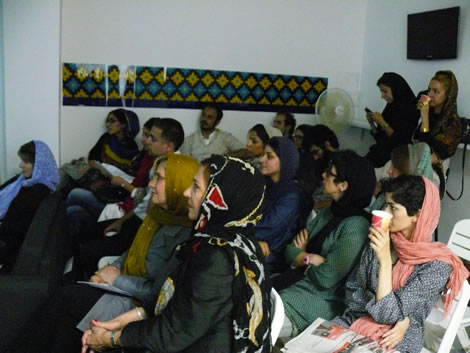 |
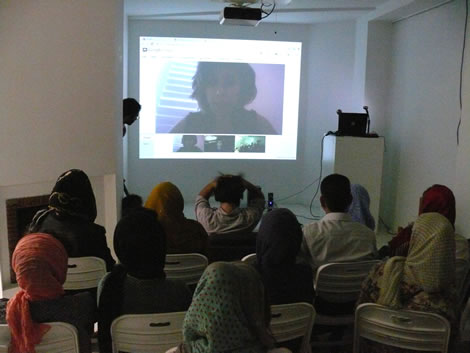 |
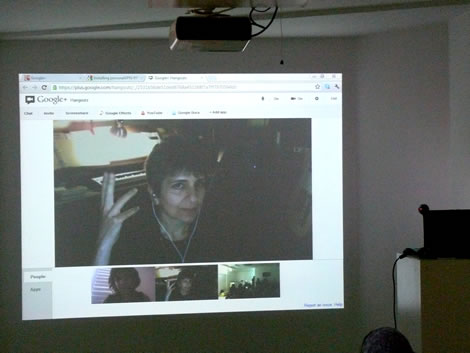 |
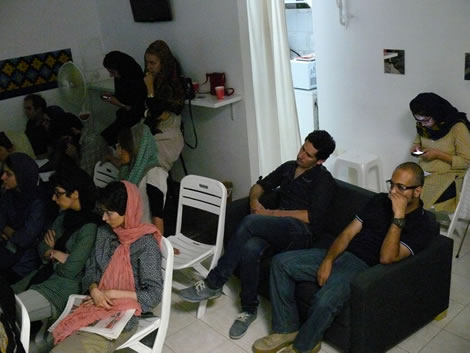 |
| Above, images of the event, courtesy of Sazmanab |
|---|
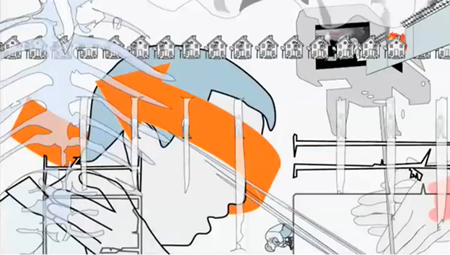 BIO Christopher Coleman received his BFA in his native state from West Virginia University in 2001 and his MFA from New York State University at Buffalo in 2003. A number of his undergraduate years were devoted to studying Mechanical Engineering, knowledge that he brings to bear in his installations. His work includes sculptures, performances and videos as well as interactive installations. Coleman was twice a participant in the VIPER Basel Festival in Switzerland and has had his work in exhibitions in Singapore, Finland, Sweden, Italy, Germany, France, China, the UK, Latvia and 14 other countries. Domestically his work has been shown at more than 40 events and festivals, Spaces Gallery in Cleveland, the Albright Knox in Buffalo NY, and the Boulder Museum of Contemporary Art to name a few. In 2009 he received the Metropolis Art Prize Grand Prize and had his work featured in Times Square NYC. He currently resides in Denver, CO and is an Associate Professor at the University of Denver. |
Christopher Coleman (Colorado, USA) "Modern Times" is an animation created over 18 months and completed in 2005. Because the Department of Homeland Security made their Terrorism Readiness brochures available in digital format, much of the imagery in the video is directly taken from the source, recontextualized, arranged and animated. The original movie, Modern Times, featured Charlie Chaplin struggling to deal with man’s relationship to technology in the Industrial Age. We have now moved into the Age of Information in which our connection to the world around us is not only defined by technology, but the information it does or does not provide. When first encountering these brochures I was struck by how they, along with other safety illustrations like those found in the back pocket of every airplane seat, are supposed to simultaneously alarm and calm us. There is no sign of fear on the faces of the generic passengers bracing for a water landing. It is interesting to note that while the public was still quite shaken from the events of 9/11 when the US government released these brochures, they were an instant source of ridicule. I have attempted to return their levity but with a different focus. Modern Times has played at numerous events in 14 countries and is on two DVD compilations. Sound Design was done by George Cicci.
|
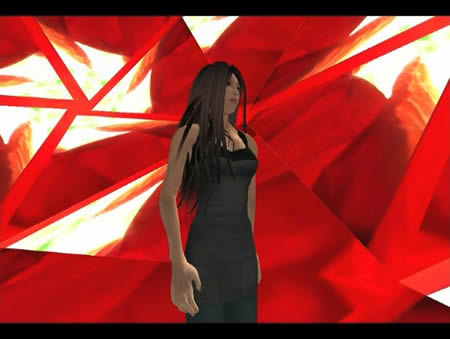 |
Sachiko Hayashi (Sweden) "N00sphere Playground" in the virtual world Second Life is an interactive sound installation in which avatars' own movements trigger various preprogrammed sounds. With its form that imitates and modifies a playground sphere, the work expresses the joy of play through the experience of interactive sounds. Beneath its surface, however, is an underlying notion of noosphere, closely related to Henri Bergson’s idea of "Èlan Vital" and its role in evolution. The machinima "N00sphere Playground" takes this installation work to another level by fusing its core concept with machinima visuals. Expressed in it is a dual position over our notion of an ideal future, a crash between its optimism and its back side.
|
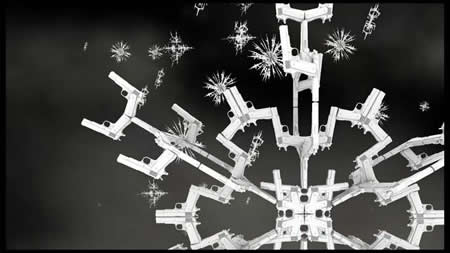 |
Shane Mecklenburger (Ohio, USA) Halcyon Atmosphere is a single-channel video made from found digital 3D models of guns. This work is part of pwn3d, a series of animations, objects and performances. pwn3d is a gaming term which refers to humiliating victory and appropriation, usually of a defeated player or computer system. The series explores the virtual gun which often serves as a stand-in for the body. I'm interested in how first-person shooter games assign value through the virtual gun to construct a particular masculine identity. |
|
Jonathan Monaghan (Brooklyn, New York) BIO |
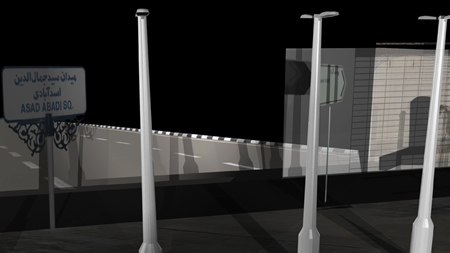 |
Morehshin Allahyari (Dallas & Denver, USA) To build a land; an imaginary home. To push the limits of real and unreal, memory and imagination, locality and universality, self censorship and self- exile, time and space. To put together my most vivid memories on flat planes or 3D cubes. Inside and outside the empty rooms, rooms without bodies, rooms left behind. To construct the remembered, missed, identical objects. Things I care for, love the most, miss the most... To put together every five sense of my body into one (“sight”) through text and animation. A reflection and presentation of emotional attachments. Collective and personal. Bio |
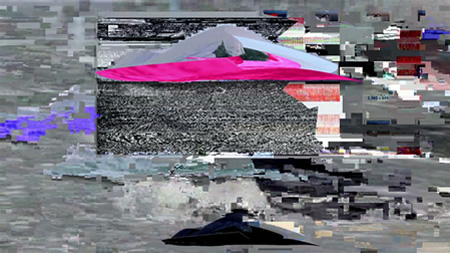 Bio His time-based works have been enjoyed on screens of all sizes; his Prepared Desktop has been performed in many localizations. Satrom performs, develops, and organizes with I ♥ PRESETS, poxparty, and GLI.TC/H; in addition to executing other initiatives with talented dirty new-media comrades. |
Jon Satrom (Chicago, USA ) When creating glitch-art, developing kludgy workflows is key. Softwares and languages with loop-holes, open-ports, and forgotten-functions are integral to constructing situations for glitching. In my mind, no other program embodied this ethic more than QuickTime. It's popularity, and the fact that it's development was to position itself within a multimedia paradigm yet-to-be solidified, makes QuickTime (versions 1.5 – 7.6) a quagmire of mystical features. The recent rewrite of QuickTime as QuickTime X threatens an environment that helped form my ideas of how malleable digital video can be. The drumbeat of "progress" has stripped esoteric codecs and functions in favor of the current flavors of standardized media consumption. Popular computer program releases are similar to code-volcanoes barfing new functions on-top of themselves creating mountains of functionality. Due to the fact that QuickTime was one of the first popular desktop video playback and editing technologies, the program is full of strange utopic abandonware. Aside from the myriad of codecs available, two of my favorite QuickTime features are QTVR and the ability to skin one's own player. These are once celebrated features are now forgotten on the edge of the volcanic crater of QuickTime 7. After working and performing with these techniques for years, I have only been moved to articulate my love and investment as I find my go-to-tool on the chopping- block of our upgrade-culture. For now, I can rest assured: it's a weird-chopping-block; there's still time. For now, QuickTime7 has been transformed from a player into a utility. Even now (OSX 10.6.6), there are elements of QuickTime X that rely on the robust functionality of QuickTime 7. When working against an upgrade culture and hesitant to celebrate a retro-ness within my own work, I'm forced to jump the shark and exploit my favorite functions before they are "legacy features"... |
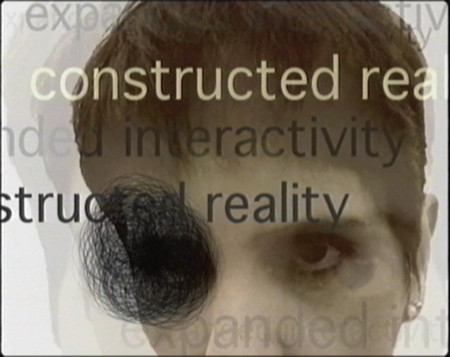 |
Alysse Stepanian & Philip Mantione (Los Angeles) |
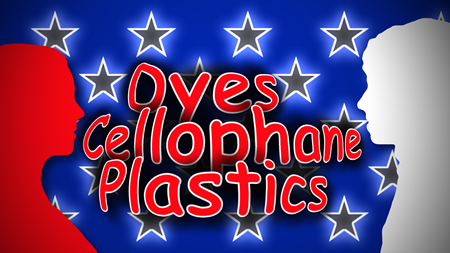 |
Michael Lasater (Indiana, USA) In Epiphany, I take medium to be the entire text of American advertising and entertainment in the 1950's and 1960's, expressed most profoundly in the content of television commercials. Two prom night sweethearts are at play in a mass media pinball game, their identities, assumptions, and aspirations all the product of American TV culture. |
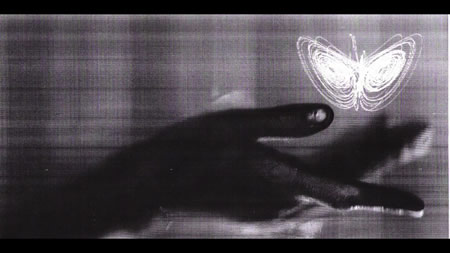 |
Jenny Vogel (New York & Dallas, USA) "The Beauty of All Things Falling" 4:30 min, 2011, Color/B&W, silent A narrative of glitches and beautiful failures. This video explores the terrifying as well as the creative potential of error. Bio |
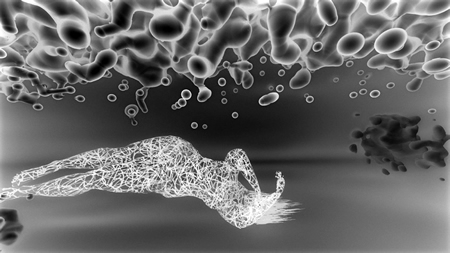 BIO |
Claudia Hart (Chicago, USA ) "Dream" 07:14 min, 2009, blk/white, sound, HD video, Music by Edmund Campion Dream is a fluid environment evoking x-rays and the style of medical imaging as well as biological elements. Semi abstract, the animation suggests cells, blood vessels and a range of the visceral emissions that come from bodies. Dream consists of two parts. In the first, a fish-eye super wide-angle virtual camera has been rotated 90 degrees to be vertically oriented in the horizontal space. In the second, the camera's view point is similarly rotated from frontal to upwards. Both camera moves are unfamiliar because impossible with analog cameras, and so were deployed to create a sense of spatial ambiguity. The sound track, by composer Edmund Campion, also functions on an edge between representation and avant-garde composition, integrating sounds emitted by bodies and fluids with classical compositional strategies. |
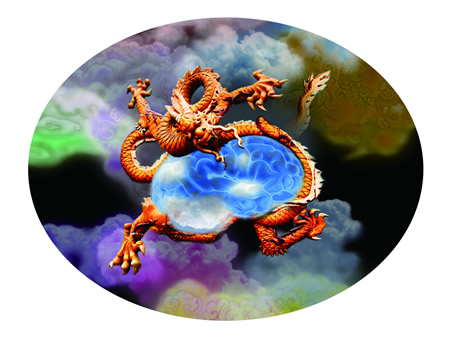 |
Lily & Honglei (New York) http://lilyhonglei.wordpress.com Lily X. Yang and Honglei Li "Dragon" 3:55 min, 2012, color, sound, Digital animation, 4:4 Dragon is created during 2012, the Chinese Lunar Dragon Year. Associating imagery of human brain with Dragon, one of the most significant cultural creations of China, the work reflects on intriguing meaning of this symbol of Power. Dragon, the imaginary, almighty creature, is the subject of many Chinese classics specially focusing on its ability of adjusting itself for controlling. This cultural icon is vividly alive throughout Chinese history, inspiring personal and national ambitions in both ancient and contemporary societies of China. Within this context, the short film visualizes how this thousand-year-old unreal creature has influenced Chinese people's mindset and thinking. BIO(S) |
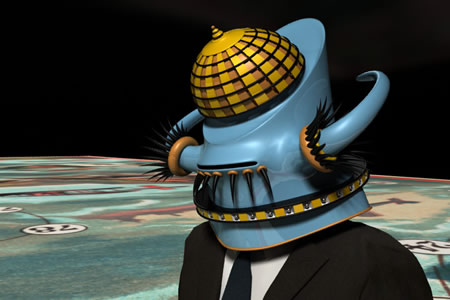 |
Gerald Guthrie (Illinois, USA) "The Realm of Possibility" 6:06 min, 2009, color, stereo, 4:3 “The Realm of Possibility” is a digital animation based at the intersection of absurdity and logic. Deductive reasoning, as found in the syllogistic form (a is b, b is c, therefore a is c), becomes a vehicle to validate concepts that might not necessarily be true. The structure of the narrative is meant to parallel the premise of a syllogism. Many men use libraries; many libraries reference aviation; therefore, many men are pilots. In the end, navigation to another planet becomes a curious byproduct of flawed logic. Guthrie teaches animation and foundation studies as a Professor in the School of Art and Design at the University of Illinois at Urbana/Champaign. His digital animations have screened in over one hundred national and international film festivals. Past screenings include the Prix Ars Electronica new media festival (2008, 2010), Anima Mundi (2010), the Melbourne International Animation Festival (2011) and the Seattle International Film Festival (2011). Guthrie’s work addresses ubiquitous questions that cannot be definitively answered. These are the questions that are woven into the fabric of culture and become the basis for such uniquely human pursuits as religion, ethics, philosophy, politics, and science. As such, he attempts to identify and exemplify many of the more inscrutable mysteries of everyday life. |
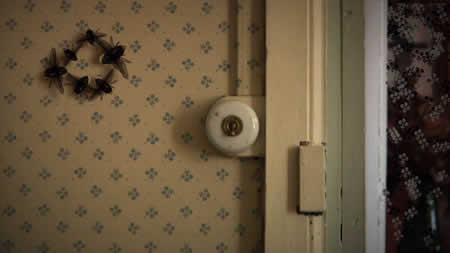 |
Albert Merino (Barcelona, Spain) "Hidden Mud" 7:42 min, 2010, color, stereo, HDV 1080i, 16:9, France Original Title- La terre occulte Time deposits itself in layers that mount up stores –in the same way than the earth- as a form of sediments. In this piece, video is used as a tool to reveal different layers and stories of a temporary location. This dissection of the space generates a convulsion where the absences and the presences will meet their self, establishing a silent dialogue. During several years he has developed an extensive work of video between the cites of Paris, Barcelona and Berlin. Using a personal and intimate language, he develops a vast imagery where the video is used as a tool to intercede in the daily life, verging often irony and absurdity. His work covers different genres from experimental films, to videodance, or fake documentaries. |
 |
Julia Zastava (Moscow, Russia) "Son of king" 4:33 min, color, sound, 4:3 "Son Of King" is about a dream and possibility of split personality inside the dream and after. This animation was made by my photographs of Orlov’s (one of the lovest favorite of empress Ekaterina II) palace which was one of the biggest palaces in Moscow’s suburb. After revolution 1917 like almost all other palaces in Russia it was harried and then abandoned. Now it is almost a ruin/ but it is stiil great/ and i think tremendous mystify::::::::::::::::::::::::::::like fantastic faint of XVIIIcentury. BIO |
